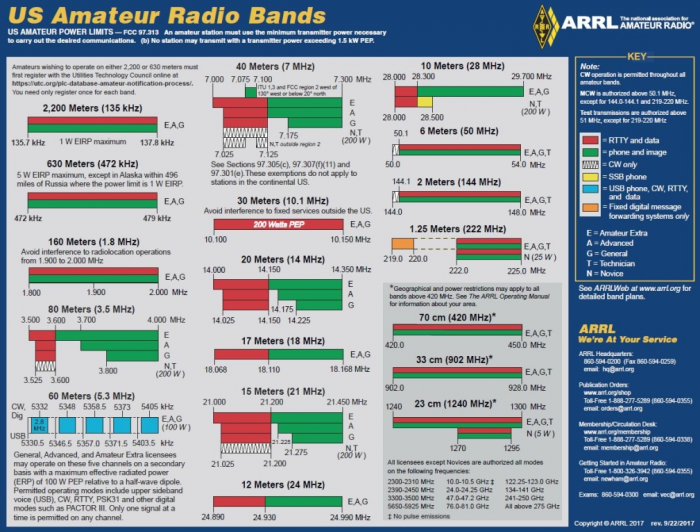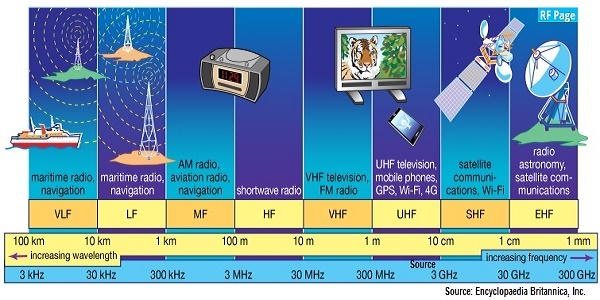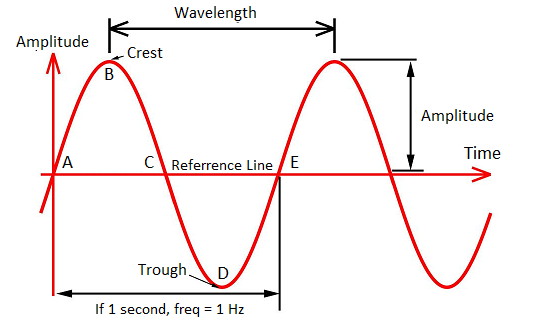Here are my notes on understanding wavelengths, frequencies and band plans. I’ll list the band plans at the top because they’re essentially just reference material. Then I’ll go on to share my notes explaining wave length and frequency. I started my study of amateur radio by understanding radio waves because they’re the most fundamental part of understanding how to operate a radio. After all, if you don’t understand what those numbers on the screen mean…do you really understand anything at all?
Band Plans

Band Plans are just sections of the spectrum that have been legally blocked off for a particular use. In the US these band plans are created by the FCC. Since we’re all hams here, I’ll stick to listing the amateur radio band plan.
While we’re here though, let’s take note of the term “band.” Band is a term meaning a contiguous set of frequencies on the electromagnetic spectrum.
Generally speaking, the meter band corresponds to the actual legal frequency range. However, out of tradition and an inability for hams to correct their past mistakes the commonly known ‘meter band’ will actually refer to a frequency range that is different that what the name indicates. For that reason, just refer to a chart.
Don’t worry, the frequency ranges and meter bands will make more sense later. For now all you need to know is that “meters” refers to wavelength and Frequency Range refers to the actual range of frequencies. When discussing band plans, just think of “meter band” as a nick name for the legal operating frequency range.
| Meter Band | Frequency Range and Use |
| 160 meters | 1800-2000 kHz ham radio |
| 120 meters | 2300-2498 kHz broadcasting |
| 90 meters | 3200 to 3400 kHz broadcasting |
| 80 meters | 3500 to 4000 kHz ham radio |
| 60 meters | 4750 to 4995 kHz broadcasting |
| 49 meters | 5950 to 6250 kHz broadcasting |
| 41 meters | 7100 to 7300 kHz broadcasting |
| 40 meters | 7000 to 7300 kHz ham radio |
| 31 meters | 9500 to 9900 kHz broadcasting |
| 30 meters | 10100 to 10150 kHz ham radio |
| 25 meters | 11650 to 11975 kHz broadcasting |
| 22 meters | 13600 to 13800 kHz broadcasting |
| 20 meters | 14000 to 14350 kHz ham radio |
| 19 meters | 15100 to 15600 kHz broadcasting |
| 17 meters | 18068 to 18168 kHz ham radio |
| 16 meters | 17550 to 17900 kHz broadcasting |
| 15 meters | 21000 to 21450 kHz ham radio |
| 13 meters | 21450 to 21850 kHz broadcasting |
| 12 meters | 24890 to 24990 ham radio |
| 11 meters | 25670 to 26100 kHz broadcasting |
| 10 meters | 28000 to 29700 kHz ham radio |
Understanding radio waves

Radio emissions are the signals that are emitted from an Antenna attached to a transceiver.
Radio waves are part of the larger electromagnetic spectrum. The electromagnetic spectrum includes all sorts of things, even visible light. For our purposes though we’ll concern ourselves only with the radio part of the electromagnetic spectrum.
Since radio emissions are wave, they are commonly measured and referred to either by their wavelength can be measured in either wavelength (λ) or their frequency. Modern usage and most radio equipment will refer to radio waves by their frequency. However, amateur radio is steeped in tradition so it’s not uncommon for verbal and written communication to refer to a radio wave by its wavelength.
Using wavelength instead of frequency can also make it easier to understand antenna sizing needs later on since the radiating elements on an antenna are typically sized based on the length of the radio wave.

Here’s a visualization of a wave that we’ll use to identify it’s different parts.
First, notice that the top of each oscillation is called a crest.
Then notice that the bottom of each oscillation is called a trough.
The distance between two crests is called the wavelength.
The height above the reference line is called the amplitude.
The graph is read from left to right with older waves on the left and newer waves on the right. Imagine it scrolling by.
Wavelengths, represented by the unit symbol λ, are measured in meters and sometimes centimeters. So referring to a 70cm wavelength means there are 70cm between one crest and the next. As an aside, you’ll remember band plans from earlier. There’s a band called the 70cm band that refers to 430-440 MHz.
Now, you may notice that wavelengths are measured in metric units. That means that a 70cm wavelength is the same as a 0.7m wavelength which is also the same as a 700mm wavelength. The metric system’s pretty cool for sciencey stuff.
So wavelength makes sense now. It’s just the distance between two consecutive crests on a wave. What about frequency?
Well, frequency is represented by f and is measured in Hertz. Hertz measures radio waves in waves per second. One Hertz (1 Hz) is equal to one complete wave per second. Therefore one kiloHertz (1 kHz) is 1,000 waves per second and one megaHertz (1 MHz) is 1,000,000 waves per second. 70 kHz = 70,000 waves per second and 660 MHz is 660,000,000 waves per second.
So, wavelength is the actual length of the wave as measured from crest to crest while frequency is the “speed” of the wave as measured by the number of waves that pass a set point in one second. Wavelength is measured in meters and frequency is measured in Hertz.
There’s one more piece of the puzzle that we need to know about. It’s just a constant, unchanging value and that’s the speed of light in a vacuum. For our purposed, we’ll identify that as C and enumerate it as 300,000,000 meters per second which is the approximate speed of light in a vacuum.
IMPORTANT: All radio waves move at the same speed, C. The wavelength may vary which changes the frequency but the speed of the wave itself is constant and unchanging.
Why do we need to know C? Because when we know that we can calculate the frequency of a radio wave when we know it’s wavelength. We do that using this formula: f = C/λ
To keep things easy, when using the f = C/λ formula the f will always be in MHz and the wavelength (λ) will always be in meters. So to calculate the frequency of a 70cm wavelength we first translate it into meters.
| 70cm = 0.7m | First, make sure our wavelength is in meters |
| f = C/0.7 | Then insert the 0.7m value into the equation |
| f = 300/0.7 | Now replace the constant for the speed of light. We can use 300 here since we’re doing everything in meters and megaHertz |
| f = 428.57 | Divide 300 by 0.7 and you receive 428.57 MHz. That’s the frequency for a 70cm wavelength. |
BUT!!! What if we know the frequency and want to know the wavelength? We just use the old high school algebra and reverse the equation to get λ = C/f
| λ = C/f | start with the formula |
| λ = C/428.57 | Plug in the known frequency in MHz |
| λ = 300/428.57 | Plug in the speed of light (300 due to units being in MHz and meters) |
| λ = 0.7m | Do the division and we see our wavelength is 0.7m or 70cm. |
TRIVIA: The moon is approximately 370,000,000 meters away from the earth (depending on specific locations and orbits) so a radio wave takes approximately 1.2 seconds to reach the moon. If you bounce a radio signal off the moon the total round trip takes about 2.5 seconds.
To check your math: Any wavelength multiplied by it’s frequency should be equal to C, the speed of light.
The important intuitive take-away here is that as frequency increases, wavelength decreases. Similarly, as wavelength increases frequency decreases. The explanation for this is that waves move at a constant speed, the speed of light. Because of this, the only way frequency can change is if the distance between crests changes. Thus a larger distance between crests (a larger wavelength) means fewer crests pass the measuring point resulting in a smaller frequency. Similarly, a smaller distance between crests allows more crests to pass the measuring point resulting in a larger/higher frequency.
A couple of misc notes that we’ll revisit more in details later…
A band is contiguous set of frequencies. For example: 144.0 MHz to 144.5 MHz. All modulation modes (CW, AM, FM, SSB, PSK31, etc) technically operating a on frequency band. When we refer to them as a particular frequency, that’s known as the carrier frequency. It’s a convention that simply tells us where to tune understanding that the actual band in use will be slightly above, below or above and below that carrier depending on the modulation mode. Again, more on that later…just mentioning it here because I found that confused by understanding of frequencies until I learned about it.
Similary, bandwidth describes the band of frequencies a modulation mode consumes…again, more on that later.
Lastly, channels are just frequency designations. It’s a legal and technical shorthand. For example, FRS Channel 1 is 462.5625 MHz.

What you should understand after reading this
- What is a wavelength?
- What is frequency?
- How is wavelength measured?
- How is frequency measured?
- How to convert a wavelength into a frequency.
- How to convert a frequency into a wavelength.
- What is a band?
- What is a band plan?